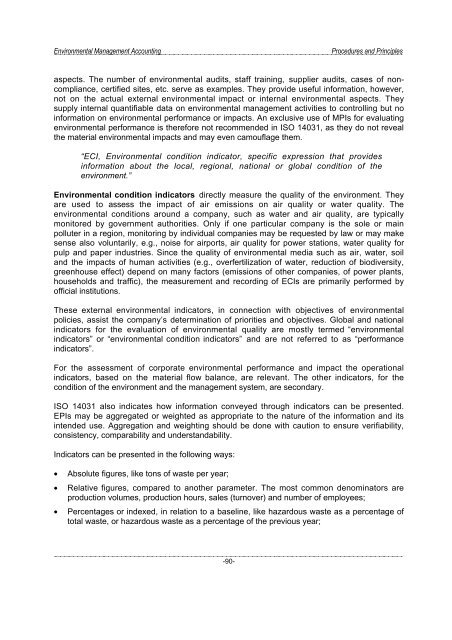Environmental Management Accounting Procedures and Principles
Environmental Management Accounting Procedures and Principles
Environmental Management Accounting Procedures and Principles
You also want an ePaper? Increase the reach of your titles
YUMPU automatically turns print PDFs into web optimized ePapers that Google loves.
<strong>Environmental</strong> <strong>Management</strong> <strong>Accounting</strong><br />
<strong>Procedures</strong> <strong>and</strong> <strong>Principles</strong><br />
aspects. The number of environmental audits, staff training, supplier audits, cases of noncompliance,<br />
certified sites, etc. serve as examples. They provide useful information, however,<br />
not on the actual external environmental impact or internal environmental aspects. They<br />
supply internal quantifiable data on environmental management activities to controlling but no<br />
information on environmental performance or impacts. An exclusive use of MPIs for evaluating<br />
environmental performance is therefore not recommended in ISO 14031, as they do not reveal<br />
the material environmental impacts <strong>and</strong> may even camouflage them.<br />
“ECI, <strong>Environmental</strong> condition indicator, specific expression that provides<br />
information about the local, regional, national or global condition of the<br />
environment.”<br />
<strong>Environmental</strong> condition indicators directly measure the quality of the environment. They<br />
are used to assess the impact of air emissions on air quality or water quality. The<br />
environmental conditions around a company, such as water <strong>and</strong> air quality, are typically<br />
monitored by government authorities. Only if one particular company is the sole or main<br />
polluter in a region, monitoring by individual companies may be requested by law or may make<br />
sense also voluntarily, e.g., noise for airports, air quality for power stations, water quality for<br />
pulp <strong>and</strong> paper industries. Since the quality of environmental media such as air, water, soil<br />
<strong>and</strong> the impacts of human activities (e.g., overfertilization of water, reduction of biodiversity,<br />
greenhouse effect) depend on many factors (emissions of other companies, of power plants,<br />
households <strong>and</strong> traffic), the measurement <strong>and</strong> recording of ECIs are primarily performed by<br />
official institutions.<br />
These external environmental indicators, in connection with objectives of environmental<br />
policies, assist the company’s determination of priorities <strong>and</strong> objectives. Global <strong>and</strong> national<br />
indicators for the evaluation of environmental quality are mostly termed “environmental<br />
indicators” or “environmental condition indicators” <strong>and</strong> are not referred to as “performance<br />
indicators”.<br />
For the assessment of corporate environmental performance <strong>and</strong> impact the operational<br />
indicators, based on the material flow balance, are relevant. The other indicators, for the<br />
condition of the environment <strong>and</strong> the management system, are secondary.<br />
ISO 14031 also indicates how information conveyed through indicators can be presented.<br />
EPIs may be aggregated or weighted as appropriate to the nature of the information <strong>and</strong> its<br />
intended use. Aggregation <strong>and</strong> weighting should be done with caution to ensure verifiability,<br />
consistency, comparability <strong>and</strong> underst<strong>and</strong>ability.<br />
Indicators can be presented in the following ways:<br />
• Absolute figures, like tons of waste per year;<br />
• Relative figures, compared to another parameter. The most common denominators are<br />
production volumes, production hours, sales (turnover) <strong>and</strong> number of employees;<br />
• Percentages or indexed, in relation to a baseline, like hazardous waste as a percentage of<br />
total waste, or hazardous waste as a percentage of the previous year;<br />
-90-




